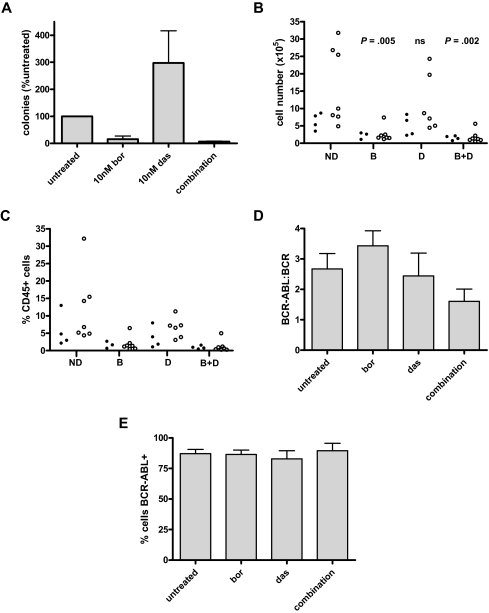Figure 4.
Effect of bortezomib on long-term colony formation and engraftment of BCR-ABL+ cells. (A) Results of LTC-IC assay in CD34+ CML (n = 2 CML samples each performed in duplicate). Results are expressed as percentage of number of colonies counted after culture of untreated cells (mean ± SEM). Cells were exposed to drug for 24 hours before long-term culture with 10nM bortezomib and 10nM dasatinib. Statistical analysis was not performed because only 2 samples were assayed. The apparent increase in colonies after dasatinib exposure is not thought to be significant. (B) Engraftment of treated CD34+ CML cells in sublethally irradiated mice. In the first experiment, 1 CML sample was exposed to no drug, bortezomib 10nM, dasatinib 10nM, or the combination of bortezomib 10nM with dasatinib 10nM for 72 hours and then injected into 4 mice per arm (ie, 16 mice; ●). In the second and third experiments, CML samples (1 per experiment) were exposed to no drug, bortezomib 20nM, dasatinib 150nM, or the combination of bortezomib 20nM with dasatinib 150nM for 24 hours and then injected into 4 mice per arm per experiment (ie, 32 mice; ○). The total number of human CD45+ cells isolated from BM at 6 weeks is shown with statistical comparison of experimental arms in comparison with untreated control. (C) The data generated from panel B are expressed as percentage of human CD45+ cells isolated from mouse BM at 6 weeks. (D) Human CD45+ cells from panel B underwent analysis by Q-PCR to determine BCR-ABL/BCR ratio. Because engraftment levels showed similar trends within each arm for the 3 CML samples assayed, the data were pooled for each treatment arm across all 3 experiments. (E) For each mouse, the percentage of CD45+ cells that is BCR-ABL+ by D-FISH is shown.

